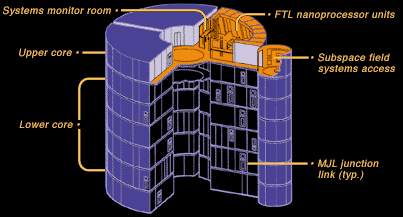The total storage capacity can reach up to 1,290,000,000 Kiloquads per core.
To give you an indication of the speed, the computer core on Voyager is capable of 575 trillion calculations per nanosecond.

|
|
|
| Probably
the single most important operational element of a starship is it's main
computer system, being responsible in some way for almost every aspect
of the ship's operation. The heart of the system is a set of three main
processing cores, which incorporate a series of miniature subspace field
generators to allow the processing of optical data at rates faster that
the speed of light. The computer cores are redundant, so any one can handle
the computing load of the entire ship, should the need arise. An intricate
optical data network (ODN) connects the cores with virtually every component
of the ship, and a subspace link is maintainded with hand-held or remote
devices needing computer access.
The total storage capacity can reach up to 1,290,000,000 Kiloquads per core. To give you an indication of the speed, the computer core on Voyager is capable of 575 trillion calculations per nanosecond. |
 |
| Advances in computer technology have allowed "living" components to be integrated into Computer Systems. Bio-neural computer connections suspended in a Gel placed in a specialized device which not only contains the gel, but provides an interface for the Bio-Naural system to the ODN network. These "gel packs" often replace Isolinear Chips in areas where space is limited, but they are more succeptable to infection as any biological network. Refitting older vessels with Gel Packs has extended the life and abilities in several of Star Fleet's ship classes. | |
| The computers in Star Trek have both voice and manual (touch) interface which run under an operating system called LCARS (in TNG, VOY and DS9 only). Galaxy Class vessels have three main computers, two reside in the primary hull (the saucer); they are vertical cylinders, about 8 decks high, and located on opposite sides of the saucer, flanking the bridge. The third computer is located in the secondary hull (engineering), and is smaller than the other two cores; it controls the Stardrive section when the ship separates. We've seen the computer cores a number of times. In 'Evolution' (TNG) the nanites were attacked in the computer cores. The set is probably meant to be just one deck of the multi-deck computer core, with the room seen the hollow central portion. | |
| The computers are networked with each other, and with the rest of the ship via the ODN (Optical Data Network) which has enough processing power on its own to take over limited control of the ship in case of a complete computer failure. That explains why systems are still accessable, even when the main computers are down. The displays use 'nanoprocessors' - cell sized mechanical computers - to display information. The display itself contains data from the ODN based on user selections, and displays whatever is requested. So even if the computers go down, whatever information is (1) already on the ODN (or ODN backups) or (2) in the display itself can be selected and displayed. | |
| The three main computer cores are equipped with low level subspace field generators which allows signal propagation within the cores at faster-than-light (FTL) speeds, allowing the computers to perform much faster than anything constructable given 20th century technology, even theoretically. This cannot be applied (by 24th century technology) to smaller computers. | |
| Until 2329, duotronics technology (invented by Dr. Richard Daystrom in 2243) formed the basis of the computers used aboard all Federation starships for over 80 years, including the main computers ('The Ultimate Computer' (TOS)). Duotronic enhancers were finally replaced by isolinear optical ships in 2329. ('Relics' (TOS)). | |